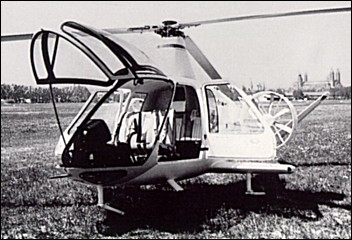
| VFW-Fokker H-5 1969 |  |
 |

| VFW-Fokker H-5 1969 |  |
 |
|
The success of the H3 version resulted in the construction of a follow-on H5 prototype which bore marked similarities to its predecessor. The H5 incorporated many H3 components, including rotor blades (although 0.6m longer), a modified H3 landing gear, along with H3 controls, tail, and tail boom. The also-similar cabin could be opened with left-side seats capable of folding for litter loading and unloading. Like the H3, there was also no hydraulic system with the H5. There were also a number of Compound Helicopter programs with H4, H7, and H9 designations. The H4 system actually incorporated a folding rotor. The H9 system was to be a much larger Compound Helicopter system with a 15.2m main rotor diameter and a maximum lift-off weight of approximately 22500kg. The H7 was to be a new five-seven passenger compound system. Basically a new design, the H7 was to have used some cabin components from the H5, along with modified H5 flying controls. S.Markman & B.Holder "Straight Up: A History of Vertical Flight", 2000 The H-3 was further developed into the H-5 which was similar in layout but had a larger cabin with five seats. The first of two prototype H-3s (H3-E1, D-9543) flew in early 1970 without the external fan propulsion units. It was intended that the H-5 would be followed by the H-7 7/8 seater (construction of which was apparently started but not completed) and the much larger H-9. As it turned out, however, further development was abandoned in 1972 following the merger of VFW and Fokker. R.Simpson "Airlife's Helicopter and Rotorcraft", 1998
|